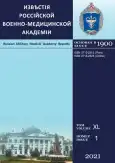Метод остановки продолжающегося кровотечения при сквозном ранении легких
- Авторы: Колобков А.К.1, Маркевич В.Ю.1
-
Учреждения:
- Федеральное государственное бюджетное военное образовательное учреждение высшего образования «Военно-медицинская академия имени С.М. Кирова» Министерства обороны Российской Федерации
- Выпуск: Том 40, № 1 (2021)
- Страницы: 11-17
- Раздел: Научные обзоры
- URL: https://bakhtiniada.ru/RMMArep/article/view/64472
- DOI: https://doi.org/10.17816/rmmar64472
- ID: 64472
Цитировать
Полный текст
Аннотация
Проанализирована структура повреждений груди в мирное и военное время, а также выполнен статистический анализ этапного лечения пострадавших с продолжающимся кровотечением при сквозном ранении легких в период войны в Афганистане, вооруженных конфликтов на Северном Кавказе и по данным историй болезни пациентов клиники военно-полевой хирургии. Структура жизнеугрожающих последствий повреждений груди в ходе военных конфликтов включала в себя развивающееся в 22,5 % случаев продолжающееся кровотечение при сквозном ранении легких; в условиях мирного времени — в 18,6 % случаев. Сформулированы медико-технические требования к способу остановки продолжающегося кровотечения при такого рода ранении. Разработаны биологическая модель сквозного ранения легкого для проведения испытаний созданного метода и способ остановки продолжающегося кровотечения при таком ранении в соответствии с медико-техническими требованиями. Экспериментально подтверждена высокая эффективность разработанного способа остановки кровотечения при сквозном ранении легкого (6 рис., 4 табл., библ.: 7 ист.).
Ключевые слова
Полный текст
Открыть статью на сайте журналаОб авторах
Артемий Константинович Колобков
Федеральное государственное бюджетное военное образовательное учреждение высшего образования «Военно-медицинская академия имени С.М. Кирова» Министерства обороны Российской Федерации
Автор, ответственный за переписку.
Email: artkolon@gmail.com
SPIN-код: 1881-4298
курсант 6-го курса
Россия, 194044, Санкт-Петербург, ул. Академика Лебедева, д. 6Виталий Юрьевич Маркевич
Федеральное государственное бюджетное военное образовательное учреждение высшего образования «Военно-медицинская академия имени С.М. Кирова» Министерства обороны Российской Федерации
Email: vitaly-med@mail.ru
SPIN-код: 5652-4935
канд. мед. наук, доцент
Россия, 194044, Санкт-Петербург, ул. Академика Лебедева, д. 6Список литературы
- Денисов А.С., Щеколова Н.Б., Ладейщиков В.М. Хирургическая тактика при сочетанной травме груди в остром и последующих периодах травматической болезни // Пермский медицинский журнал. 2019. Т. 36, № 3. С. 11–17. doi: 10.17816/pmj36311-17
- Евдокимов С.В., Баулин А.В., Евдокимов М.Е., и др. Некоторые особенности организации проведения хирургического эксперимента на свиньях // Успехи современного естествознания. 2015. № 1–5. С. 756–759.
- Иноземцев Е.О., Григорьев Е.Г., Апарцин К.А. Актуальные вопросы хирургии сочетанных повреждений (по материалам публикаций журнала «Политравма») // Политравма. 2017. № 1. С. 6–10.
- Самохвалов И.М., Головко К.П., Бояринцев В.В., и др. Обоснование концепции раннего патогенетического лечения тяжелых ранений и травм // Вестник Российской военно-медицинской академии. 2020. № 3. С. 23–28.
- Самохвалов И.М., Мануковский В.А., Бадалов В.И., и др. Применение тактики многоэтапного лечения («damage control») в военно-полевой хирургии // Военно-медицинский журнал. 2011. Т. 332, № 9. С. 30–35.
- Asensio J.A., Ogun O.A., Mazzini F.N., et al. Predictors of outcome in 101 patients requiring emergent thoracotomy for penetrating pulmonary injuries // European Journal of Trauma and Emergency Surgery. 2018. Vol. 44, No. 1. P. 55–61. doi: 10.1007/s00068-017-0802-x
- Geldenhuys A. Thoracic Damage Control Surgery // Current Trauma Reports. 2018. Vol. 4, No. 3. P. 177–182.
Дополнительные файлы













